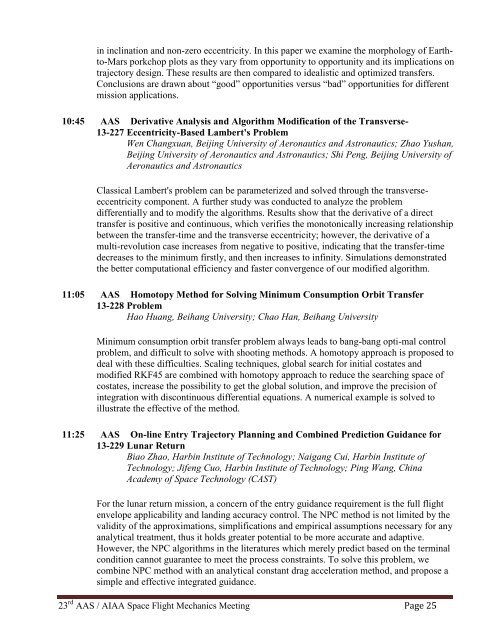meetings - Space Flight Mechanics Committee
meetings - Space Flight Mechanics Committee
meetings - Space Flight Mechanics Committee
Create successful ePaper yourself
Turn your PDF publications into a flip-book with our unique Google optimized e-Paper software.
in inclination and non-zero eccentricity. In this paper we examine the morphology of Earthto-Mars<br />
porkchop plots as they vary from opportunity to opportunity and its implications on<br />
trajectory design. These results are then compared to idealistic and optimized transfers.<br />
Conclusions are drawn about “good” opportunities versus “bad” opportunities for different<br />
mission applications.<br />
10:45 AAS Derivative Analysis and Algorithm Modification of the Transverse-<br />
13-227 Eccentricity-Based Lambert's Problem<br />
Wen Changxuan, Beijing University of Aeronautics and Astronautics; Zhao Yushan,<br />
Beijing University of Aeronautics and Astronautics; Shi Peng, Beijing University of<br />
Aeronautics and Astronautics<br />
Classical Lambert's problem can be parameterized and solved through the transverseeccentricity<br />
component. A further study was conducted to analyze the problem<br />
differentially and to modify the algorithms. Results show that the derivative of a direct<br />
transfer is positive and continuous, which verifies the monotonically increasing relationship<br />
between the transfer-time and the transverse eccentricity; however, the derivative of a<br />
multi-revolution case increases from negative to positive, indicating that the transfer-time<br />
decreases to the minimum firstly, and then increases to infinity. Simulations demonstrated<br />
the better computational efficiency and faster convergence of our modified algorithm.<br />
11:05 AAS Homotopy Method for Solving Minimum Consumption Orbit Transfer<br />
13-228 Problem<br />
Hao Huang, Beihang University; Chao Han, Beihang University<br />
Minimum consumption orbit transfer problem always leads to bang-bang opti-mal control<br />
problem, and difficult to solve with shooting methods. A homotopy approach is proposed to<br />
deal with these difficulties. Scaling techniques, global search for initial costates and<br />
modified RKF45 are combined with homotopy approach to reduce the searching space of<br />
costates, increase the possibility to get the global solution, and improve the precision of<br />
integration with discontinuous differential equations. A numerical example is solved to<br />
illustrate the effective of the method.<br />
11:25 AAS On-line Entry Trajectory Planning and Combined Prediction Guidance for<br />
13-229 Lunar Return<br />
Biao Zhao, Harbin Institute of Technology; Naigang Cui, Harbin Institute of<br />
Technology; Jifeng Cuo, Harbin Institute of Technology; Ping Wang, China<br />
Academy of <strong>Space</strong> Technology (CAST)<br />
For the lunar return mission, a concern of the entry guidance requirement is the full flight<br />
envelope applicability and landing accuracy control. The NPC method is not limited by the<br />
validity of the approximations, simplifications and empirical assumptions necessary for any<br />
analytical treatment, thus it holds greater potential to be more accurate and adaptive.<br />
However, the NPC algorithms in the literatures which merely predict based on the terminal<br />
condition cannot guarantee to meet the process constraints. To solve this problem, we<br />
combine NPC method with an analytical constant drag acceleration method, and propose a<br />
simple and effective integrated guidance.<br />
23 rd AAS / AIAA <strong>Space</strong> <strong>Flight</strong> <strong>Mechanics</strong> Meeting Page 25
















